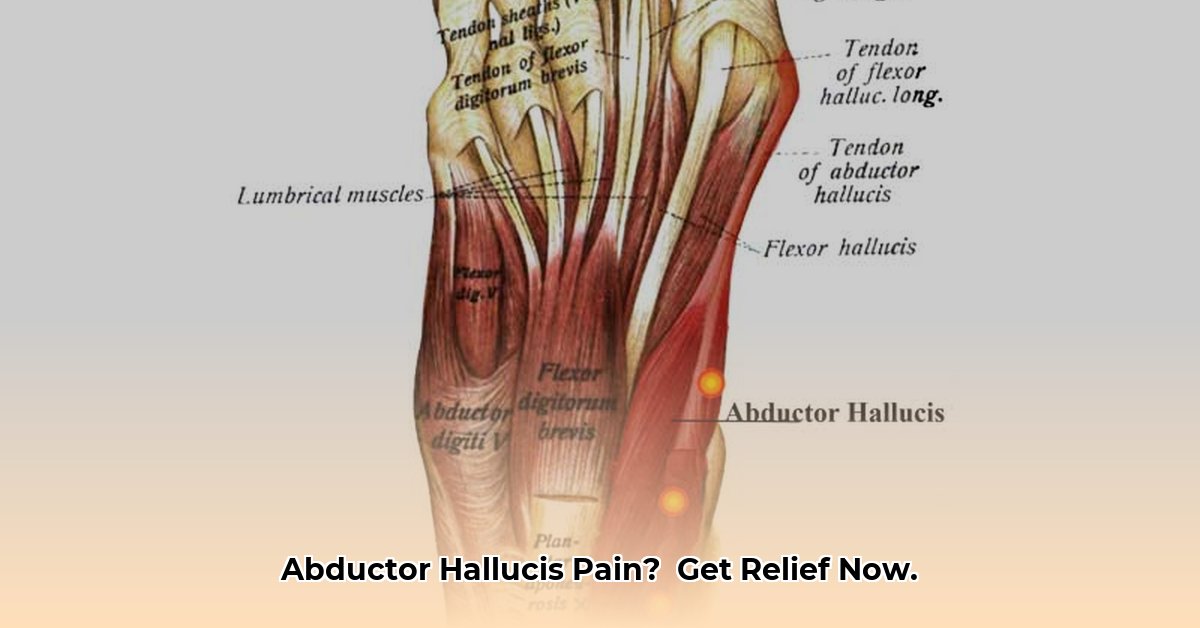This guide provides practical advice and in-depth information about abductor hallucis pain, helping you understand, manage, and potentially prevent this common foot ailment.
Understanding the Abductor Hallucis Muscle
The abductor hallucis is a vital muscle located along the inner edge of your foot, extending from your heel to the base of your big toe. Its primary function is to pull your big toe away from the other toes (abduction) and plays a role in maintaining the arch of your foot, contributing to balance and stability.
What Causes Abductor Hallucis Pain?
Several factors can contribute to abductor hallucis pain. Overuse, particularly in activities like running or dancing, is a frequent culprit. Ill-fitting footwear, especially shoes lacking arch support or those that constrict the toes, can also place undue stress on this muscle. Biomechanical factors like flat feet or overpronation (inward rolling of the foot) can exacerbate the problem. Even seemingly minor injuries, such as a twisted ankle, can strain the abductor hallucis. Finally, bunions can irritate the muscle due to their proximity.
Recognizing the Symptoms
Symptoms of abductor hallucis pain typically include:
- Pain along the inner arch: This may range from a dull ache to a sharp, stabbing sensation, often worsening with activity.
- Tenderness: Pressing along the inner edge of the foot may elicit pain.
- Swelling: The affected area may appear swollen.
- Difficulty walking: Pushing off with the big toe can be painful, impacting gait.
- Instability: The arch may feel less stable than usual.
Self-Diagnosis and When to See a Doctor
While you can assess your symptoms at home, it’s crucial to seek professional medical advice for a definitive diagnosis. Try gently palpating the inner edge of your foot for tenderness. Note whether the pain increases when walking barefoot or in flat shoes. If your pain is severe, accompanied by significant swelling, or hinders weight-bearing, consult a doctor immediately. If self-care measures fail to alleviate pain within a few days, medical evaluation is warranted.
Treatment Options
Self-Care Strategies
Several self-care measures can help manage abductor hallucis pain:
- Rest: Avoid activities that exacerbate pain, allowing the muscle to recover.
- Ice: Apply ice packs to the affected area for 15-20 minutes at a time, several times daily, to reduce inflammation and numb pain.
- Taping: Supporting the arch with athletic tape can enhance stability and alleviate strain. Search online for video tutorials on proper taping techniques.
- Orthotics: Over-the-counter or custom-made orthotics can provide arch support and correct biomechanical issues like overpronation. Choose orthotics designed to support the medial arch.
- Stretches and Exercises: Gentle stretches and targeted strengthening exercises can promote flexibility and prevent recurrence. Consult a physical therapist or podiatrist. Here are some examples:
- Big Toe Stretch: Gently pull your big toe toward your ankle, holding for 20 seconds. Repeat several times throughout the day.
- Toe Curls: Place a small towel on the floor and use your toes to scrunch it toward you, repeating 10-15 times.
- Marble Pickup: Pick up small objects like marbles with your toes to improve dexterity and strength.
| Self-Care Strategy | Description | Benefits |
|---|---|---|
| Rest | Avoid aggravating activities. | Promotes healing and reduces inflammation. |
| Ice | Apply ice packs for 15-20 minutes. | Numbs pain and decreases inflammation. |
| Taping | Support the arch with athletic tape. | Stabilizes and reduces strain. |
| Orthotics | Wear arch supports. | Corrects biomechanics and reduces pressure. |
| Stretching & Exercises | Perform specific stretches and exercises. | Improves strength and flexibility. |
Medical Treatments
If self-care proves insufficient, a doctor might recommend:
- Anti-inflammatory Medications: Nonsteroidal anti-inflammatory drugs (NSAIDs) like ibuprofen can reduce pain and swelling. Consult your doctor before use, especially if you have underlying health conditions.
- Physical Therapy: A physical therapist can design a personalized exercise program to strengthen the abductor hallucis and improve foot mechanics.
- Corticosteroid Injections: In some cases, corticosteroid injections may offer temporary pain relief but are generally not a long-term solution.
| Medical Treatment | Description | Benefits | Potential Drawbacks |
|---|---|---|---|
| NSAIDs | Over-the-counter or prescription pain relievers. | Reduces pain and swelling. | Potential gastrointestinal side effects. |
| Physical Therapy | Targeted exercises and stretches. | Restores function, improves strength and flexibility. | Requires time and commitment. |
| Corticosteroid Injections | Injections to reduce inflammation. | Provides rapid pain relief. | Temporary solution; potential side effects. |
Prevention
Preventing abductor hallucis pain involves several strategies:
- Proper Footwear: Choose shoes with good arch support, ample toe room, and a comfortable fit, avoiding high heels or overly tight shoes.
- Gradual Increase in Activity: Increase exercise intensity gradually to prevent overuse injuries.
- Regular Stretching: Stretch your feet and ankles regularly, focusing on the plantar fascia and calf muscles.
- Weight Management: Maintaining a healthy weight can reduce stress on your feet.
- Addressing Biomechanical Issues: Consult a podiatrist for orthotics or other interventions if you have flat feet, overpronation, or other structural foot problems.
Ongoing Research and Evolving Perspectives
Research into foot mechanics is ongoing, and current understanding suggests that these strategies are likely beneficial. Studies are exploring the relationship between abductor hallucis pain and other foot conditions like plantar fasciitis. Further research promises to reveal more about the complex interplay of foot and ankle structures.
Conclusion
Abductor hallucis pain, while a common ailment, is often manageable with appropriate care. By understanding the muscle’s function, recognizing the symptoms, and implementing self-care and medical treatments as needed, you can effectively manage this condition and potentially prevent recurrence. Remember, consulting a healthcare professional is crucial for an accurate diagnosis and personalized treatment plan.
- How Did Charles F. Brush Discover Wind Energy Tech? - November 19, 2025
- Wind Energy Vertical: Weighing the Pros and Cons of Wind Power - November 16, 2025
- How Much Energy Does a Wind Turbine Actually Create? - November 14, 2025
















